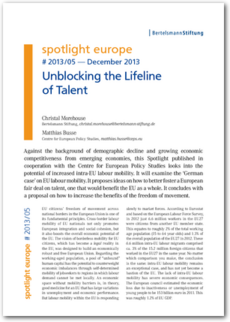EU citizens’ freedom of movement across national borders in the European Union is one of its fundamental principles. Cross-border labour mobility of EU nationals not only promotes European integration and social cohesion, but it also boosts the overall economic potential of the EU. The vision of borderless mobility for EU citizens, which has become a legal reality in the EU, was designed to build an economically robust and free European Union. Regarding the working-aged population, a pool of “unbound” human capital has the potential to counterweight economic imbalances through self-determined mobility of jobseekers to regions in which labour demand cannot be met locally. An economic space without mobility barriers is, in theory, good medicine for an EU that has large variations in unemployment and economic performance. But labour mobility within the EU is responding slowly to market forces. According to Eurostat and based on the European Labour Force Survey, in 2012 just 6.6 million workers in the EU27 were citizens from another EU member state. This equates to roughly 2% of the total working age population (15 to 64 year olds) and 1.3% of the overall population of the EU27 in 2012. These 6.6 million intra-EU labour migrants comprised ca. 3% of the 15.2 million foreign citizens that worked in the EU27 in the same year. No matter which comparison you make, the conclusion is the same: intra-EU labour mobility remains an exceptional case, and has not yet become a bastion of the EU. The lack of intra-EU labour mobility has severe economic consequences. The European council estimated the economic loss due to inactiveness or unemployment of young people to be 153 Billion euro in 2011. This was roughly 1.2% of EU GDP.
Bertelsmann Stiftung (Hrsg.)
Christal Morehouse, Matthias Busse
spotlight europe 05/2013: Unblocking the Lifeline of Talent
- Ausgabeart
- Erscheinungstermin
- 01.12.2013
- Auflage
- 1. Auflage
Format
-
PDF
Preis
kostenlos



